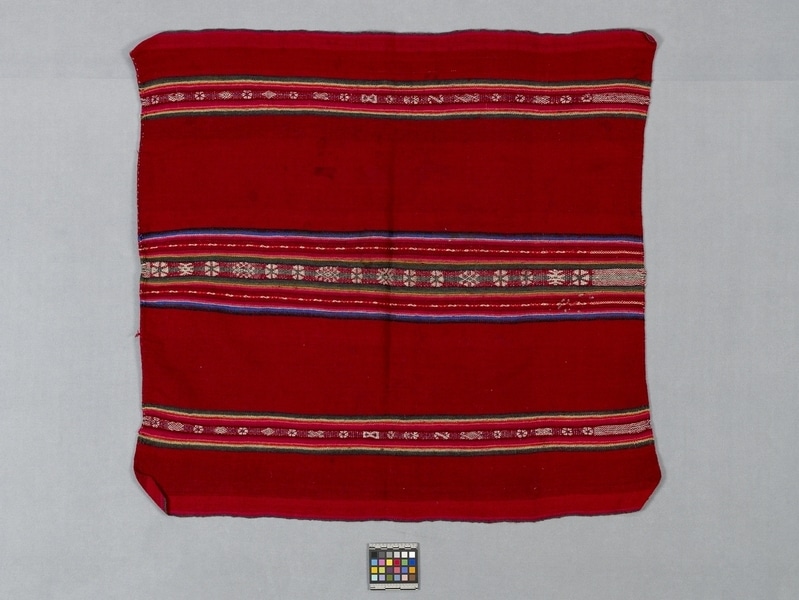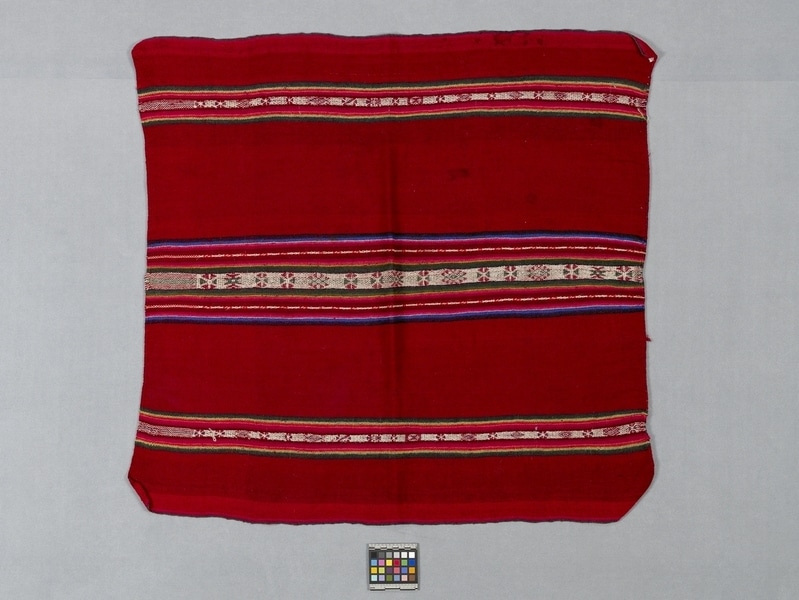Shawl Item Number: Sf1017 from the MOA: University of British Columbia


Description
Shawl made of woven red wool with three stripe groupings symmetrically arranged. The largest stripe is centred and has a middle band of geometric motifs flanked by graduated prismatic colours and narrow bands with tiny motifs. The lateral stripe groupings are identical with each having a middle band of geometric motifs flanked by red, orange, yellow and green stripes. The geometric designs include a six-part circle, a rayed diamond, diamonds with triangles appended, a reverse curve and a striated cross.
History Of Use
The techniques, structures and some of the motifs have pre-Conquest antecedents. This type of textile conveys the most about an individual's ethnicity, sex, age, status and particular history. Red patterned cloths like this one are used by women in various fiestas and life events. Like the black carrying cloth in everyday use, it can be used as a garment to cover the shoulders or a container to carry things. The manner in which it is worn is specific to the occasion. A bride wears this as a truncated diamond pinned to the front of her skirt. Another one is worn over the shoulder. For the fiesta or carnival, it is worn as a carrying cloth on the back with ends passing over the shoulders and knotted on the chest. For the Fiesta of Candelaria, it is worn like a shawl around the shoulders, with the stripes horizontal and the top edge folded down.
Cultural Context
special occasions
Iconographic Meaning
The range of motifs refers to local geography and landmarks, ecology, fecundity as well as luck. The 6 part circle refers to the division of land into 6 sections on Taquile and the rotation of crops and fallow periods. The diamonds and crosses with striations refer to the cultivated terraces or 'andanes'. Diamonds with triangular flags refer to a dance done at a wedding. The reserve curve or s-shape refers to the hook shaped pier or hooked thorns on roses.
Narrative
Bought from Carmen Flores Huatta, the daughter of the maker. It has been used on many occasions by 3 generations of one family. Most recently, Carmen's daughter, Elena, wore it when she married Domingo Quispe Cruz. She wore it as a truncated triangle pinned to the front of her skirt when she demonstrated the wedding clothes she wore in July, 1987. Carmen and before her, her mother, wore it for dancing in the Fiesta of Carnival each year. They also wore it for the Fiesta Santiago.
Specific Techniques
Primarily handspun and plied sheep's wool, z-2 s. Small amount of blue and orange commercial synthetic yarn and white alpaca, similarly spun and plied. Yarn dyed. One loom piece with 4 selvedges woven to its finished shape on a continuous warp. Warp faced plain weave combined with complementary-warp weave with 3 span floats aligned in alternate pairs.
Item History
- Made by Dionisia Huatta Huatta (Maker) in Taquile, Puno, Peru during 1950
- Collected by Mary Frame during 1987
- Owned by Carmen Flores Huatta
- Owned by Mary Frame before November 3, 1987
- Received from Mary Frame (Seller) and Museum of Anthropology Shop Volunteers (Funding source) on November 3, 1987
What
- Name
- Shawl
- Identification Number
- Sf1017
- Type of Item
- shawl
- Material
- wool fibre, synthetic fibre, alpaca wool fibre and dye
- Manufacturing Technique
- spun, plied, woven and sewn
- Overall
- height 82.0 cm, width 89.0 cm
Who
- Culture
- Quechua
- Creator
- Dionisia Huatta Huatta (Maker)
- Field Collector
- Mary Frame
- Previous Owner
- Carmen Flores Huatta and Mary Frame
- Received from
- Mary Frame (Seller) and Museum of Anthropology Shop Volunteers (Funding source)
Where
- Holding Institution
- MOA: University of British Columbia
- Made in
- Taquile, Puno, Peru
When
- Creation Date
- during 1950
- Collection Date
- during 1987
- Ownership Date
- before November 3, 1987
- Acquisition Date
- on November 3, 1987
Other
- Item Classes
- textiles
- Condition
- good
- Accession Number
- 1274/0031